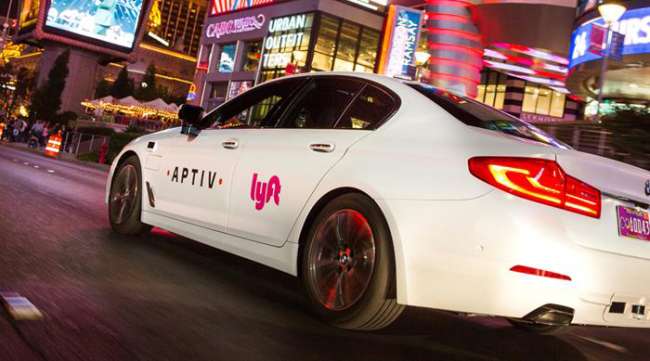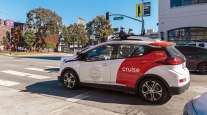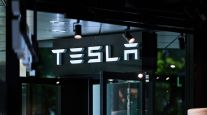Self-Driving Cars Hit Las Vegas Streets for Tech Tradeshow

LAS VEGAS — The self-driving car is getting closer to deployment in the real world for everyday passengers.
It is already here – more or less – for the nearly 200,000 trade industry folks expected to attend this week’s consumer electronics extravaganza in Las Vegas, now known simply as CES.
A fleet of eight autonomous BMW 5 Series sedans will shuttle conventioneers to 20 destinations across the city, sharing Las Vegas’ busy roadways with the regular traffic and any street-crossing pedestrians.
RELATED: Self-driving vehicle proving ground opens near Detroit
The vehicles were transformed into self-driving sedans by Aptiv, formerly known as the mobility arm of Delphi. And they are all connected to the Lyft ride-hailing app.
The Aptiv/Lyft self-driving demonstration will be the most prominent example of autonomous driving at this year’s event, which opened Jan. 7 for media previews and officially starts Jan. 9.
Traditionally known as a gadget-fest, CES has been attracting greater interest in recent years from automakers and suppliers as cars have become increasingly viewed as platforms for the latest technology, including all-electric vehicles and the high-level blending of computers, sensors and software needed to pull off autonomous vehicles.
Two years ago, General Motors used CES to unveil its groundbreaking Chevrolet Bolt electric vehicle.
While none of the Detroit 3 has announced plans to unveil any autonomous vehicles at the show this week, executives from GM, Ford and Fiat Chrysler will be on hand. Ford CEO Jim Hackett is one of the event’s keynote speakers Jan. 9.
Ford is also expected to reveal more about its autonomous vehicle business strategy. The company has been aiming to have a fully autonomous vehicle in production by 2021.
Aptiv did a self-driving demonstration of its own at last year’s CES using a 6.3-mile loop on Las Vegas streets and highways. However, this year’s demonstration with Lyft is considered a step up in difficulty, as there is no dedicated loop and the destinations all require lengthy city driving – a more unpredictable environment than the freeway.
RELATED: Aptiv to open Boston office, adding to self-driving work in Pittsburgh
The past year also has seen improvements in the array of vehicle senors and self-driving software, said James Zizelman, Aptiv’s vice president, engineering and program management.
“In terms of the braking and the acceleration, it feels more like you and I were driving the vehicle than grandmother, or some crazy guy,” said Zizelman, who is usually based at the Troy campus Aptiv shares with Delphi Technologies, its former powertrain segment that spun off in December. “Overall, it’s just more refined year-over-year.”
This year’s self-driving demonstrations still have a driver behind the wheel for safety reasons.
Waymo, the year-old Google company dedicated to autonomous driving, is so far the only U.S. company to announce a self-driving car service without a person in the driver’s seat. That driverless service was to begin late last year in the Phoenix area and use self-driving Chrysler Pacificas.
The new Aptiv-outfitted cars stand out for what they don’t have: a large spinner on the roof known as LiDAR, which acts like a light-beam radar and is key to many autonomous vehicle systems. For many, this coffee urn-size device is visually synonymous for an autonomous car.
But rooftop LiDAR is aesthetically clunky, tantamount to a civilian version of a Michigan State Police car’s bubble light.
So Aptiv installed nine smaller Velodyne-made LiDARs in the front, back and sides of its newest demonstration car. The result is a vehicle that, to a bystander, is hard to discern as a self-driving car.
“These are very subtle,” said Zach Peterson, Aptiva’s North American Government Relations Manager. “It looks pretty close to a normal commercial vehicle.”
CES is the second large public demonstration of an autonomous Lyft. Last month, the ride service began serving riders in a Boston neighborhood using a small fleet of Renault cars that were transformed into autonomous vehicles by a startup firm – nuTonomy – now owned by Aptiv.
A Free Press reporter was a passenger during a Jan. 7 Aptiv/Lyft demonstrations, making a 20-minute round-trip between the Las Vegas Convention Center and Caesars Palace.
The ride felt essentially indistinguishable from that done by a human, a contrast from the plodding, overly cautious driving style that marked some earlier generations of autonomous vehicles.
The car successfully managed a U-turn and slowed down without causing a jolt when it was cut off by a pickup truck.
However, the human driver took control from the computer for about 10 seconds as the car approached a parked bus that was extending into the car’s lane. The driver slowed the car and briefly crossed into the neighboring lane to avoid the bus.
In the self-driving car industry, that is called a “takeover” event.
Zizelman, the Aptiv engineering executive, said later that the car’s sensors would have likely maneuvered it past the bus on its own.
“The car would have been just fine,” he said, “but it would have been uncomfortably close for you as the passenger, and probably for the bus driver as well.”
Zizelman said the people in the driver’s seats during this week’s autonomous demonstration are erring on the side of caution.
“You could turn the industry backwards many many years if you have an unfortunate event,” he said. “So it’s very important, while you’re still in development, to be absolutely certain that if something were to go wrong, you’re there to fix it.”
Distributed by Tribune Content Agency, LLC




